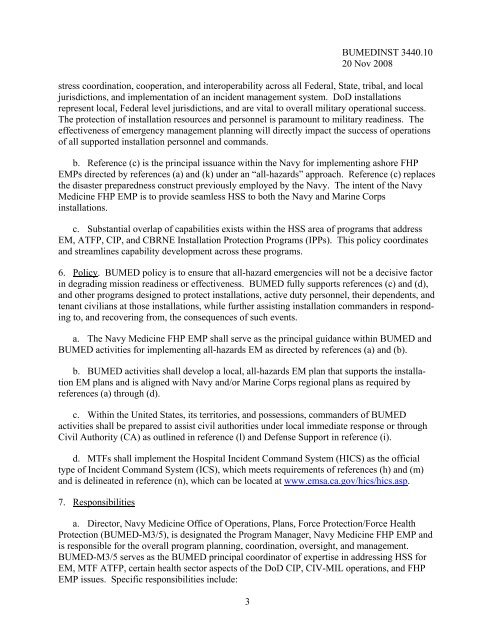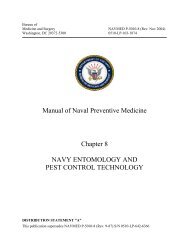3440.10 with Changes - Navy Medicine - U.S. Navy
3440.10 with Changes - Navy Medicine - U.S. Navy
3440.10 with Changes - Navy Medicine - U.S. Navy
You also want an ePaper? Increase the reach of your titles
YUMPU automatically turns print PDFs into web optimized ePapers that Google loves.
BUMEDINST <strong>3440.10</strong><br />
20 Nov 2008<br />
stress coordination, cooperation, and interoperability across all Federal, State, tribal, and local<br />
jurisdictions, and implementation of an incident management system. DoD installations<br />
represent local, Federal level jurisdictions, and are vital to overall military operational success.<br />
The protection of installation resources and personnel is paramount to military readiness. The<br />
effectiveness of emergency management planning will directly impact the success of operations<br />
of all supported installation personnel and commands.<br />
b. Reference (c) is the principal issuance <strong>with</strong>in the <strong>Navy</strong> for implementing ashore FHP<br />
EMPs directed by references (a) and (k) under an “all-hazards” approach. Reference (c) replaces<br />
the disaster preparedness construct previously employed by the <strong>Navy</strong>. The intent of the <strong>Navy</strong><br />
<strong>Medicine</strong> FHP EMP is to provide seamless HSS to both the <strong>Navy</strong> and Marine Corps<br />
installations.<br />
c. Substantial overlap of capabilities exists <strong>with</strong>in the HSS area of programs that address<br />
EM, ATFP, CIP, and CBRNE Installation Protection Programs (IPPs). This policy coordinates<br />
and streamlines capability development across these programs.<br />
6. Policy. BUMED policy is to ensure that all-hazard emergencies will not be a decisive factor<br />
in degrading mission readiness or effectiveness. BUMED fully supports references (c) and (d),<br />
and other programs designed to protect installations, active duty personnel, their dependents, and<br />
tenant civilians at those installations, while further assisting installation commanders in responding<br />
to, and recovering from, the consequences of such events.<br />
a. The <strong>Navy</strong> <strong>Medicine</strong> FHP EMP shall serve as the principal guidance <strong>with</strong>in BUMED and<br />
BUMED activities for implementing all-hazards EM as directed by references (a) and (b).<br />
b. BUMED activities shall develop a local, all-hazards EM plan that supports the installation<br />
EM plans and is aligned <strong>with</strong> <strong>Navy</strong> and/or Marine Corps regional plans as required by<br />
references (a) through (d).<br />
c. Within the United States, its territories, and possessions, commanders of BUMED<br />
activities shall be prepared to assist civil authorities under local immediate response or through<br />
Civil Authority (CA) as outlined in reference (l) and Defense Support in reference (i).<br />
d. MTFs shall implement the Hospital Incident Command System (HICS) as the official<br />
type of Incident Command System (ICS), which meets requirements of references (h) and (m)<br />
and is delineated in reference (n), which can be located at www.emsa.ca.gov/hics/hics.asp.<br />
7. Responsibilities<br />
a. Director, <strong>Navy</strong> <strong>Medicine</strong> Office of Operations, Plans, Force Protection/Force Health<br />
Protection (BUMED-M3/5), is designated the Program Manager, <strong>Navy</strong> <strong>Medicine</strong> FHP EMP and<br />
is responsible for the overall program planning, coordination, oversight, and management.<br />
BUMED-M3/5 serves as the BUMED principal coordinator of expertise in addressing HSS for<br />
EM, MTF ATFP, certain health sector aspects of the DoD CIP, CIV-MIL operations, and FHP<br />
EMP issues. Specific responsibilities include:<br />
3
















